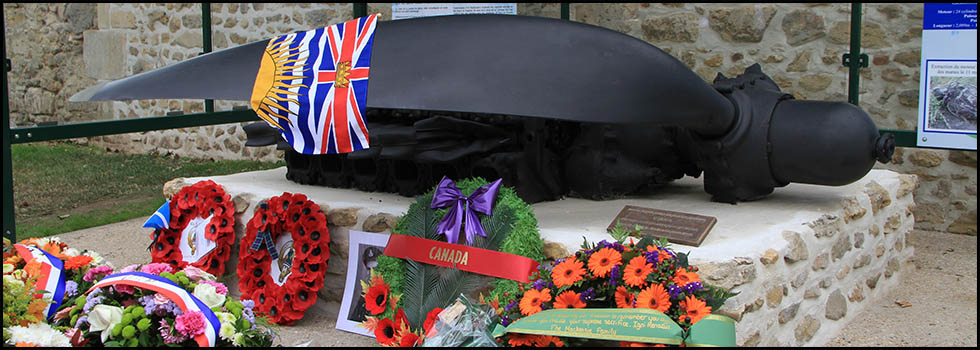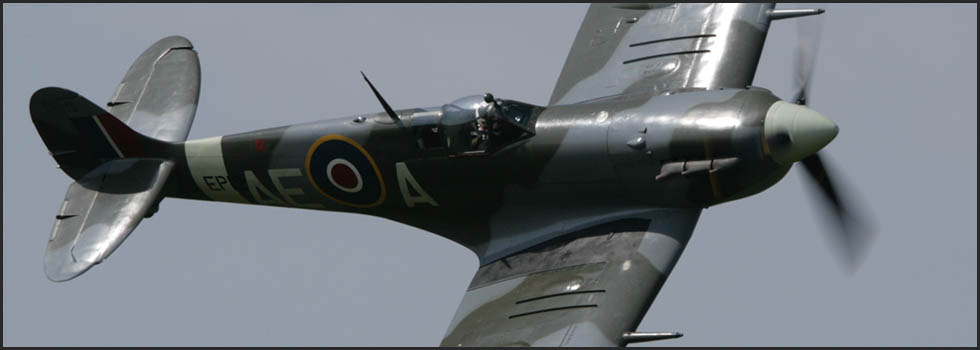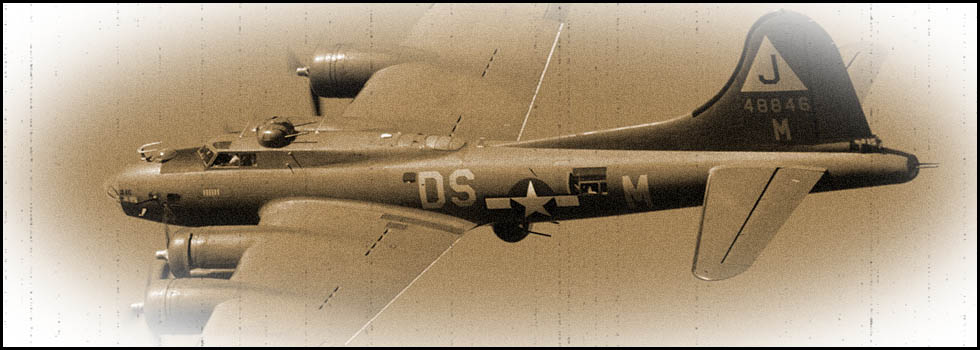10th May 1944
Martin B-26 "Marauder" #42-96058
394th Bomb Group
585th Bomb Squadron
9th Air Force
Leglantiers (Oise)
The B-26 “Marauder” # 42-96058 belonged to the 394th Bomb Group, 585th Bomb Squadron of the 9th Air Force, also called the "Bridge Busters" based in Boreham, Essex, England. The 394th Bomb Group participated in the preparation of the future Landings in Normandy by striking bridges, marshalling yards, airfields and V-weapons sites.
The crew of the B-26 #42-96058 :
| Capt. James A. JOY | Pilot | POW | Edinburg, Texas |
| 2nd Lt. John O. JOHNSON | Copilot | POW | Oklahoma |
| Sgt. William L. EDGE | Navigator/Bombardier | Evaded then POW | Tuscaloosa, Alabama |
| S/Sgt. Harold J. MAYNARD | Enginner | POW | Racine, Wisconsin |
| S/Sgt. Louis I. WATTS | Radio-operator | Evaded | Little Rock, Arkansas |
| Pvt. Joseph J. HOULIHAN | Tail gunner | Evaded | Philadelphia, Pennsylvania |
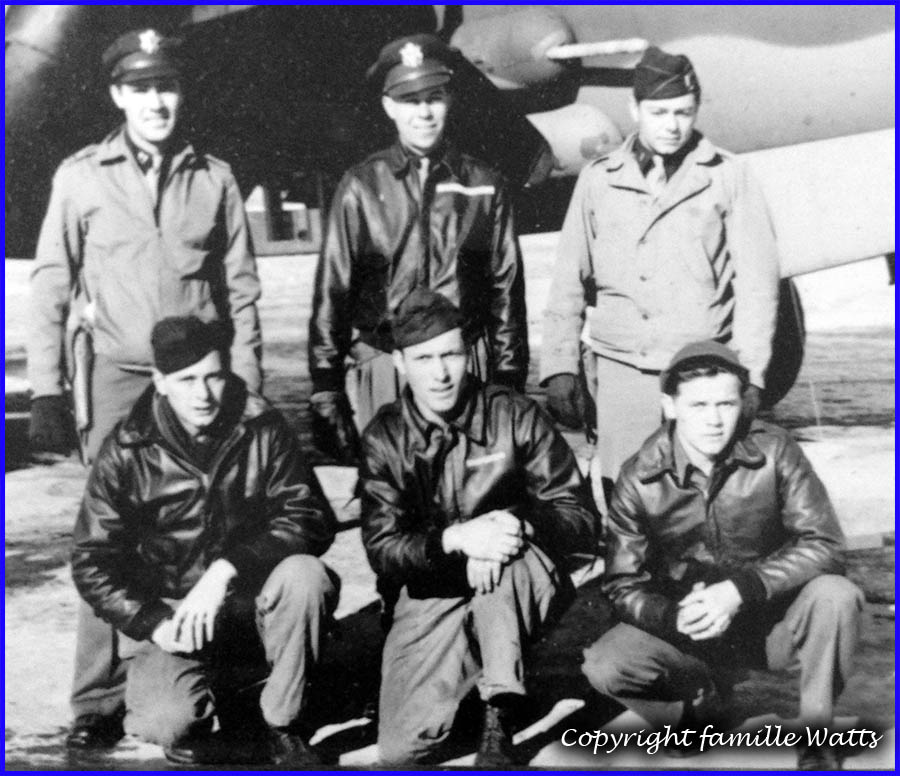
First row. On the left : S/Sgt. Louis I Watts. On the right : Pvt. Joseph J. Houlihan
On 10th May 1944, the 394th Bomb Group was preparing to carry out its 33rd mission over occupied territory. Its target was railway installations in Creil. This bombing was part of the “Desert Rail” Operation which consisted of destroying all the railways leading to the coasts of the North Sea, the English Channel and the Atlantic with the aim of hampering the influx of German reinforcements. A true railway hub, Creil was a highly strategic target for the Allies. Creil was in the immediate vicinity of Saint-Leu d'Esserent where the V1-weapons were assembled. The target of 10th May was to annihilate the depots of locomotives, the marshalling yards and the rotunda.
39 B-26s accompanied by "Pathfinders" were deployed in six "boxes". Having taken off at 7:00 am from Boreham, they reached the target at about 10:30 am and dropped in successive waves nearly 62 tons of bombs. The results were considered excellent by Bomber Command and constituted, according to Brigadier General Samuel E. Anderson, "a major step forward in the current campaign to hinder the movement of enemy troops and military equipment." The locomotive depot was 70% destroyed and the rotunda was put out of use. However, this bombardment caused considerable collateral destruction of the surrounding neighbourhoods. The civilian casualties were significant, 74 dead and more than one hundred injured, mainly related to the presence in the station of a passenger train. The report of the Chamber of Commerce and Industry during the month of May noted that "Creil will be soon a dead city, the marshalling yard is destroyed, the locomotive depot is razed, the station has disappeared and many inhabitants have taken refuge elsewhere ".

Creil - The station after the bombing of 10th May 1944.

Creil and its railway facilities
During this raid, the 394th Bomb Group however suffered the loss of a crew. The German anti-aircraft defense, the "Flak", managed to hit the "Marauder" # 42-96058 piloted by Captain James A. Joy. This latter and his co-pilot, 2nd Lt. John O. Johnson and the engineer S/Sgt. Harold J. Maynard were injured. The aircraft, hit right at the front, quickly became out of control. Smoke escaped from the starboard engine, the instruments on board, the radio and the hydraulic system no longer responded. The intercoms were inoperative and complicated the communication between the crew members. The six men on board had no choice but to leave the plane at 9,000 ft. The B-26 left alone to drift progressively lost altitude, described a wide circle and eventually crashed and exploded 500 meters south-east of the village of Leglantiers around 10:30 am.
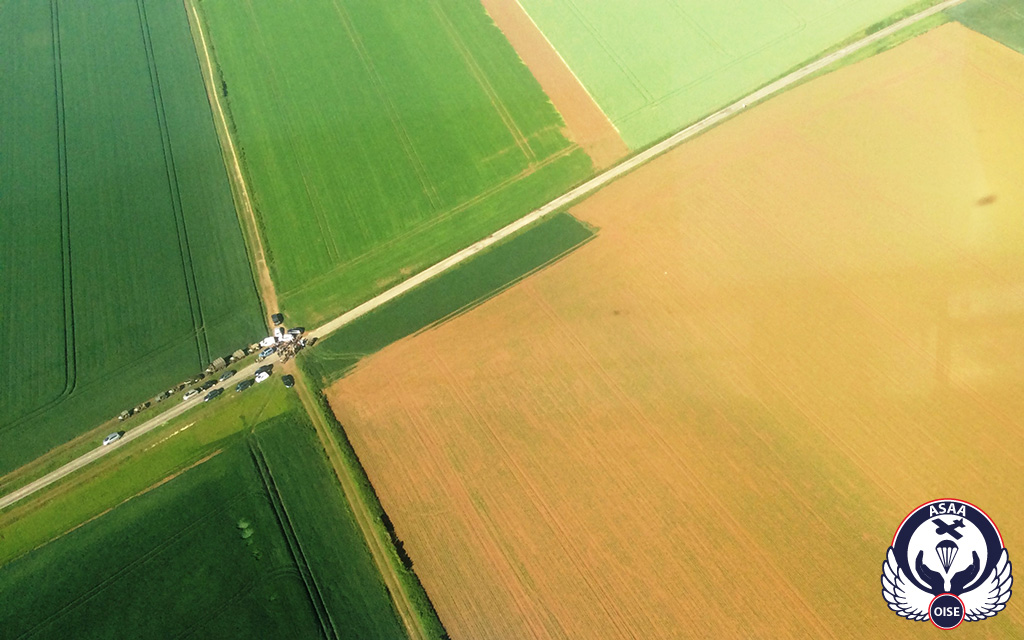
Leglantiers - The crash site
The six airmen were immediately actively sought. From then on, the alert was given to the German Military Police of Montdidier and Compiegne. Around 11:30 am, Captain Joy, 2nd Lt. Johnson and S/Sgt. Maynard, injured and unable to escape, were probably captured near the village of La Neuville-Roy. S/Sgt. Louis I. Watts (radio-operator), Sgt. William L. Edge (navigator/bombardier) and Pvt Joseph J. Houlihan (tail gunner) landed near the village of Ravenel. French people quickly came to help these last three who would succeed in escaping German searches.
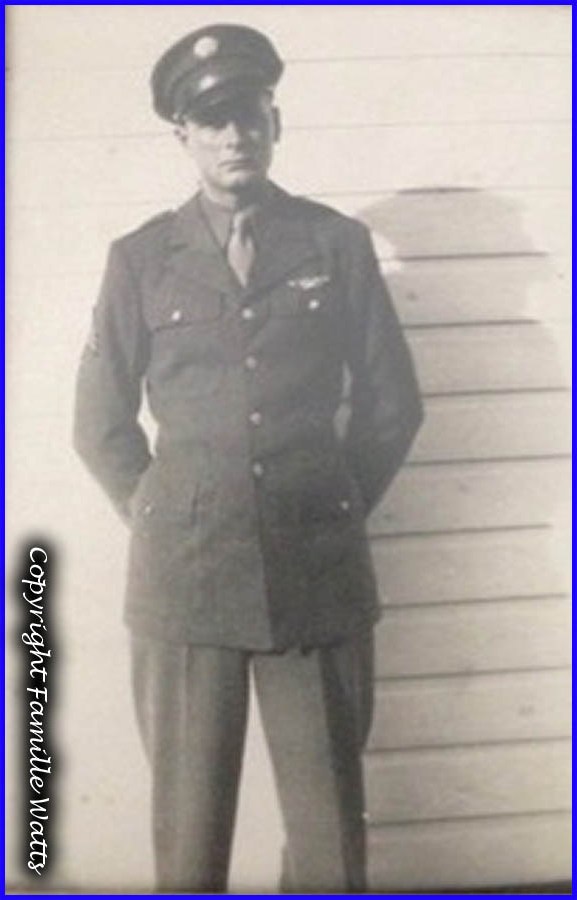 S/Sgt Louis I. Watts S/Sgt Louis I. Watts |
 Pvt. Joseph J. Houlihan
|
 |
Captain Joy and his copilot Johnson were directed to the German military hospital in Beauvais and then, like the engineer Maynard, taken to German prison camps.
The precise circumstances of the care of the airmen Watts, Houlihan and Edge after their landings remain unknown. From 10th to 12th May, Joseph Houlihan followed a different route from Louis Watts and William Edge. In the interval, the latter found refuge at Saint-Just-en-Chaussee, a stronghold of an important detachment of the Resistance. Both were taken in by Jean Crouet, 41 years old and a chemical engineer. The latter declared that he had taken them over from Doctor Caillard, a celebrated figure of the local Resistance known for his involvement in helping the Allied airmen who fell in the Saint-Just-en-Chaussee area (he helped 87 of them). Aboard his Simca and with an authorization to circulate, Doctor Caillard again appeared as the saviour in charge of collecting the fugitive airmen and to organizing their accommodation. Louis Watts and William Edge stayed only one night or two at Jean Crouet’s before being transferred to another destination.


Dr Edmond Caillard Jean and Madeleine Crouet
The presence of the three airmen in Saint-Just-en-Chaussee was communicated to Georges Jauneau known as "Captain Jacques" a member of the General F.F.I Staff in the Oise. In May 1944, he was about to assume command of the FFI and FTP troops in the Centre-Nord sector of the Oise (about 2,000 men). Georges Jauneau also lived in Saint-Just-en-Chaussee where the FTP detachment "Jacques Bonhomme" was established (about 200 men). It was under his responsibility that the three airmen were directed to an escape network. On 12th May, the three airmen were led by his right hand man, Marc Cuny, to the village of Froissy. Marc Cuny, a refractaire, was sought by the Gestapo. He actively participated in numerous attacks with the "Jacques Bonhomme" detachment (sabotage of locomotives, railways, transport of arms and clandestine newspapers, attacks of convoys etc...). Always a volunteer for dangerous missions, he moved Allied airmen gathered in the region, not hesitating if necessary to crash the German roadblocks. On several occasions, he took in charge the transport of Louis Watts, Joseph Houlihan and William Edge.
Froissy held the reserve of the "Jacques Bonhomme" led by the group leader Jean Louvet. Eugene Ropital and Jean Boisselin had entered the Resistance in November 1943. Both assured the accommodation of the airmen for three weeks. They would give them a certain sense of stability after the two hectic days they had just passed since the crash of their aircraft.
Louis Watts and Joseph Houlihan were taken care of by Juliette and Eugene Ropital. Aged 56, Eugene was a saddler. From that day, Watts and Houlihan would follow the same route until the Liberation. William Edge was entrusted to Marguerite and Jean Boisselin. The latter, also aged 56, was a "merchant of novelties". Eugene Ropital and Jean Boisselin made every effort to guarantee the hospitality of their allied hosts who, in addition, had the age of their own children. From this improbable encounter was born a friendship, immortalized by a series of photos taken in Jean Boisselin’s courtyard.
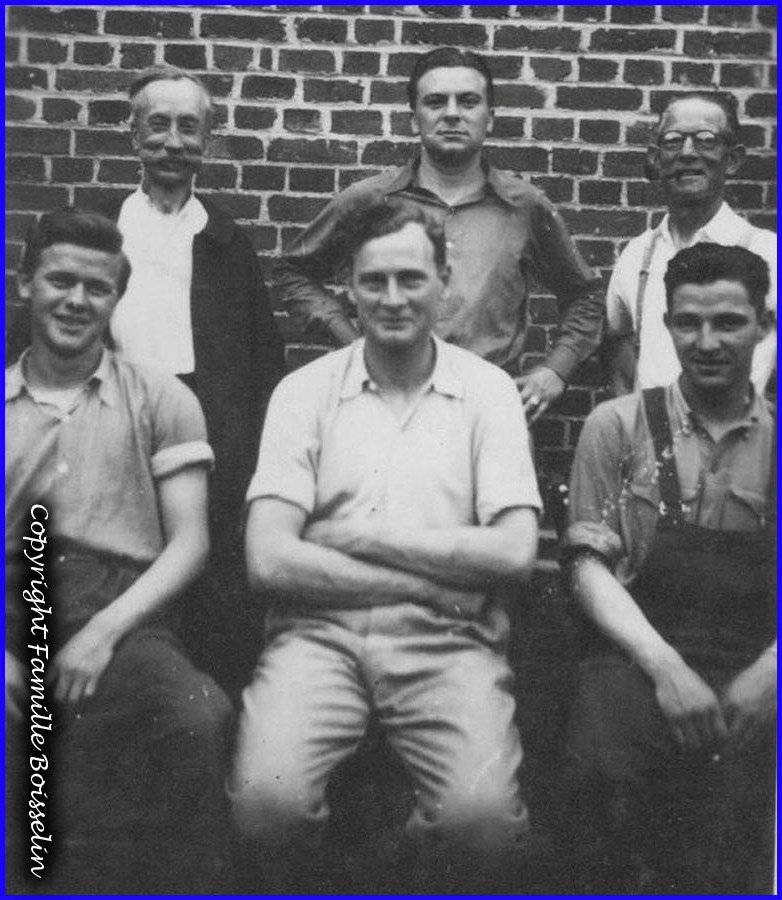
2nd row : Eugene Ropital, X, Jean Boisselin
After 21 days together, Louis Watts, Joseph Houlihan and William Edge had to hurriedly leave their respective families. On 3rd June, the Germans invested the village and proceeded to search houses. Marc Cuny urgently returned to recover the three airmen and drove them back to Saint-Just-en-Chaussee.
Although the three airmen were no longer under his responsibility, Jean Boisselin continued to keep abreast of their journeys during the weeks following their departure. He would also pursue the fight by participating in the recovery of food cards for the benefit of the refractories. Eugene Ropital would again be with him when the time for the particularly violent fighting for the Liberation in this locality would come. Shortly afterwards, Eugene Ropital was appointed President of the Local Liberation Committee of Froissy.
Louis Watts, Joseph Houlihan and William Edge were taken to Yvonne Fossier, aged 26 who lived in rue de Paris at Saint Just-en-Chaussee. Yvonne Fossier was in contact with the members of the "Jacques Bonhomme" detachment. She had previously taken in four other American airmen in January for a few days. Louis Watts and Joseph Houlihan stayed for a week at her home and were then brought by Marc Cuny to Wavignies. William Edge stayed with Yvonne Fossier until 3rd July.

From left to right : Lucien Bertin, Joseph Houlihan, Yvonne Fossier, Louis Watts, Suzanne Lequien, William Edge.
The departure of William Edge was brought about by the tragic German repressive measures which struck Saint-Just-en-Chaussee and the surrounding area. Since the Allied Landings in Normandy, the Resistance intensified its actions which raised the concern of the occupying forces. They consequently reinforced the population controls and carried out searches and arrests. On the morning of 3rd July, a wave of arrests occurred in Saint-Just-en-Chaussee. The raid was on a large scale. The Gestapo and the Feldgendarmerie encircled the bottom of the rue de Paris. Around 20 patriots were arrested. Marc Cuny and Georges Jauneau managed at the very last moment to escape from the occupier after a manhunt of several hours. The Germans also searched the house of Yvonne. Her companion Paul Begue, himself sought after as a refractaire, had the presence of mind to shut himself up with William Edge in a rabbit hutch. They remained for two hours suspended with "the machine guns of the Boches passing between their legs". Suzanne Lequien, a friend and a neighbour of Yvonne, was not unaware of the presence of William Edge. Faced with this precarious situation, she decided to help while the Germans crisscrossed the neighbourhood.
In what Georges Jauneau described as an act of "magnificent audacity and courage" she introduced herself to Yvonne Fossier and succeeded in extracting William Edge from the mousetrap by hiding him in a pram. Paulette, Yvonne’s daughter who was only a few months old, was placed above. Suzanne Lequien brought William Edge to a safe place, right under the noses of the enemy, to the home of Irene Bourgoin, the sister of Paul Begue. Suspected, Yvonne Fossier was later questioned by the Germans. Her home was thoroughly searched in order to find Paul Begue who in the meantime had managed to escape.
The patriots arrested during this large-scale raid were incarcerated at the Compiegne prison and then at Royallieu camp. The majority of them will be deported on 17th August to the Buchenwald concentration camp. Georges Jauneau's home in rue de Paris who narrowly escaped arrest, was looted by the Germans who also stole his car.
After his perilous escape to the home of Irene Bourgoin, on 6th July William Edge went painfully on a bike to the home of Jean Boisselin in Froissy. He stayed there only a few hours before being then driven on a motorcycle by Robert Moulet to the village of Beauvoir.
Robert Moulet, a cattle dealer in Caply, decided to place William Edge at Henri Ménard’s, a farm worker with 8 children. The same day, the fighter pilot Harry Hunter also arrived at his house. Since 1st June, Henri Ménard already took in an Australian airman, Mervyn Fairclough. Due to lack of space and due to his large family, he entrusted William Edge and Harry Hunter to his father-in-law, Joseph Le Mouel, who lived a few hundred meters away. The two airmen stayed there until 28th July...
On 7th June 1944, Louis Watts and Joseph Houlihan, guided by Marc Cuny, were in Wavignies, a small agricultural village of 650 inhabitants. Two major events had recently marked this locality: in January, the Resistance destroyed four 200,000 liter tanks of alcohol intended for the Germans, causing a gigantic fire. Then, in February a Flying Fortress belonging to the 306th Bomb Group crashed near the village. The struggle against the occupier was also part of this village. A Resistance group had long been established, mainly around two charismatic men: Jean Dupuy and Henri Vincenot.
A resistant from the outset, Jean Dupuy began his activities in 1941. As a teacher at the Wavignies school, he was one of those teachers who helped to set up the Front National in the Oise alongside Edmond Leveille. He was promoted to leader of the Wavignies group in March 1942, then second in command of the Saint-Just-en-Chaussee sector in May 1943 in the "Jacques Bonhomme" detachment. In June 1944, he continued his promotions by integrating the FFI departmental staff with the rank of Captain.
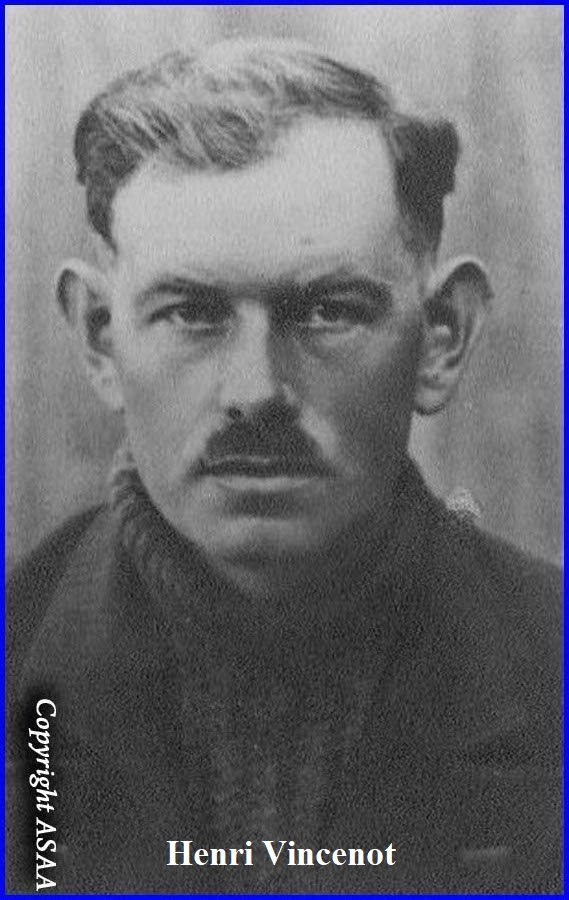 Henri Vincenot's experience was marked by the same commitment. Caretaker of the chateau since the end of 1941, Henri, aka "Gustave", entered the Resistance through his friend Jean Dupuy who introduced him to Georges Jauneau at the beginning of 1943. From then on, “his bravery and his ability to command” made him quickly climb the ladder. In the wake of Jean Dupuy, he became the Group leader in Wavignies, then Chief of the maquis of Catillon-Fumechon. In March 1944, when the detachment was attached to the FFI General Staff, “Gustave” was appointed Lieutenant and took over the command of the Wavignies, Ansauvillers, Gannes and Catillon-Fumechon groups.
Henri Vincenot's experience was marked by the same commitment. Caretaker of the chateau since the end of 1941, Henri, aka "Gustave", entered the Resistance through his friend Jean Dupuy who introduced him to Georges Jauneau at the beginning of 1943. From then on, “his bravery and his ability to command” made him quickly climb the ladder. In the wake of Jean Dupuy, he became the Group leader in Wavignies, then Chief of the maquis of Catillon-Fumechon. In March 1944, when the detachment was attached to the FFI General Staff, “Gustave” was appointed Lieutenant and took over the command of the Wavignies, Ansauvillers, Gannes and Catillon-Fumechon groups.
Jean Dupuy and Henri Vincenot were at the origin of numerous raids such as derailments, sabotage of power lines, attacks of German convoys and parachute receptions of weapons. The meetings of the group were organized at the chateau which, although requisitioned by the Germans, remained unoccupied. Weapons were also hidden in the property. In addition to the direct actions against the occupier, the group also assisted young people, resistants in difficulty as well as Allied airmen who were shot down in the area, providing civilian clothing, accommodation and false documents. Several expeditions were carried out by Henri Vincenot against town councils to seize food tickets in order to ensure the supply of these men and the group. Many of the airmen were taken in by the Vincenot couple in the chateau. To do this, Henri Vincenot was assisted by his wife Yvonne who spared no effort to help them. Wavignies then became a recognized center of accommodation, in connection with various escape routes where about twenty Allied airmen converged. From this nucleus, a network of helpers had been established throughout the surrounding farms. Among them, Antoinette Dhuyvetter with whom Joseph Houlihan and Louis Watts were sheltered.
Antoinette Dhuyvetter was 38 years old and lived in the rue Mathias. Her husband, Pierre, a carpenter before the mobilization, was then a prisoner of war in Germany since 1940. Jean Dupuy then proposed to her to take in three American airmen: Louis Watts, Joseph Houlihan and 1st Lt. Harry F. Hunter (a fighter pilot whose P-47 was shot down on 30th May 1944). Antoinette accepted and received on 7th June the three airmen who were taken in charge for three weeks with the complicity of a friend Josepha Socka. Lucien Sueur who was the mayor of the village provided supplies and clothes. It was during this interval that everyone learned of the outbreak of a major military operation on the Normandy coast, namely D-Day. In this precariousness situation, there was the immense hope of deliverance. On 28th June, Marc Cuny, accompanied by Henri Vincenot, picked up the three airmen and transferred them to the village of Puits-la-Vallee.
prisoner of war in Germany since 1940. Jean Dupuy then proposed to her to take in three American airmen: Louis Watts, Joseph Houlihan and 1st Lt. Harry F. Hunter (a fighter pilot whose P-47 was shot down on 30th May 1944). Antoinette accepted and received on 7th June the three airmen who were taken in charge for three weeks with the complicity of a friend Josepha Socka. Lucien Sueur who was the mayor of the village provided supplies and clothes. It was during this interval that everyone learned of the outbreak of a major military operation on the Normandy coast, namely D-Day. In this precariousness situation, there was the immense hope of deliverance. On 28th June, Marc Cuny, accompanied by Henri Vincenot, picked up the three airmen and transferred them to the village of Puits-la-Vallee.
Five days later, like in Saint-Just-en-Chaussee, the Germans surrounded the locality between 4 and 5 am and made arrests. The chateau was a priority target. In anticipation of the threat, Henri Vincenot took refuge in the evening of the day before in a neighbouring outbuilding near his home and took out his weapons ready for the arrival of the Germans. After opening fire on the enemy, he was apprehended and taken in front of his house where he was shot in front of his wife and his two young children. Meanwhile, Jean Dupuy was arrested at his home just like the mayor of the village Lucien Sueur. The Germans were not unaware of the presence of Allied airmen gathered in the village. They then searched the chateau thoroughly and investigated a large number of dwellings. Four airmen were in this trap. F/O Louis Greenburgh (RCAF) and Sgt. William Brown (RAF) were sheltered by Henri Reant, Mayor's secretary, and his wife Marie. The latter heard the shooting from the chateau and immediately hid the two airmen under fagots in a barn. They were not discovered but Henri Reant was however arrested. The two other British airmen, Sgts. Fred Carey and Richard Woosnam were arrested at Joseph Bugar’s and his companion Marie Dubzak while they were hidden in a hole under a heap of manure. In total, about fifteen people were arrested and gathered in the chateau. Antoinette Dhuyvetter was not arrested but admitted to having been very afraid that day, according to a letter sent after the war to Joseph Houlihan.
At Wavignies, most of the arrested resistants were then incarcerated at the Compiegne prison. For several days, they were subjected to violent interrogations in order to obtain confessions. They were then transferred to the Nazi transit camp at Royallieu, from where they left on 17th August in the infamous "Men 40, Horses 8" wagons. On that day, 1,250 men embarked in what was the last convoy of deportees from Royallieu to the German concentration camps under terrible transport conditions (overloaded cars, extremely hot sun, lack of air and water). Not everyone would come back.
On 28th June 1944, Joseph Houlihan, Louis Watts and Harry Hunter left Wavignies with good guides. They were taken by Marc Cuny and Henri Vincenot to Puits-la-Vallee where Paul Grenaud, the head of the local Resistance, awaited them. To avoid any mistakes, it was agreed to drop the three Americans at the edge of a wood, near the village. Paul Grenaud picked up Louis Watts and Joseph Houlihan in a cart and took them to his home. 1st Lt. Harry Hunter followed another route. Jacques Naillon picked him up and took him to his home, in the hamlet of Hedencourt, near Saint Andre-Farivillers. This decision will change the destiny of Harry Hunter who will find William Edge on 6th July in Beauvoir.
Circumstances of the arrest of William Edge
In July 1944, the German intelligence services were preparing an operation with the aim of infiltrating the Resistance networks of the Breteuil region. They were helped in this task by two Frenchmen who entered the service of the enemy. The latter, pretending to be resistants, gained the confidence of certain patriots who gave them valuable information and revealed to them the presence of Allied airmen in the area.
The two false-resistants pretended to be able to repatriate the airmen by air to England. Naturally wary, Robert Moulet was convinced and fell into the trap too.
On 27th July, the Australian Mervyn Fairclough and three British airmen (Geoffrey Bennett, Philip Dowdeswell and Patrick Hegarty) were led by Robert Moulet and his assistant Guy Brillé aboard a horse-drawn cart to a barn in the hamlet of Warmaise, halfway between Bonvillers and Chepoix. At the rendezvous point fixed, they were put in the presence of the false resistants. A short time later, a car arrived with two armed men on board (actually German police in civil clothes). These took the four airmen who were delivered to a group of Gestapo agents a few kilometers away.
The next day, 28th July in the afternoon, William Edge, Harry Hunter and an English airman, Peter Taylor, suffered the same fate. This time it was in the Bois des Moines, south of Bonvillers, that they were entrusted without any suspicion to the two sinister individuals. Agents of the Gestapo, arrived in the same vehicle as the day before and soon after stopped the three airmen, on the road leading to Ansauvillers.
On 29th July, the Australian airmen James Gwilliam, Eric Johnston, Keith Mills and Robert Mills were brought in a vehicle to a place near Chepoix. Guy Brillé then took over and took them on foot towards Breteuil. At the agreed place, in a thicket, they were joined by Robert Moulet and the two so-called resistants, this time accompanied by an accomplice. Unfortunately, the same process as the previous days was repeated. A little further, the German police captured the four Australians who were taken to Beauvais.
On the 2nd of August, a new rendezvous with the traitors was fixed at Tartigny. Having in the meantime acquired the conviction that he had been fooled, Robert Moulet did not attend and expressly recommended his resistant friends to disappear from the sector. Unfortunately, some refused to believe him. Knowing that they had been unmasked, the false resistants triggered, on the night of 2nd to 3rd August, a wave of arrests and looting, supported by their accomplices and the German police in the villages of Bacouel, Bonvillers, Chepoix and Tartigny. Twenty sympathizers of the Resistance were arrested and then incarcerated at the Agel barracks in Beauvais where they underwent, for the most part, violent interrogations. On 17th August, 16 of them were deported from Compiegne to Buchenwald concentration camp, 10 did not return. Fortunately, the Ménard and Le Mouel families escaped these arrests.
The 11 airmen arrested during the days of 27th, 28th and 29th July were imprisoned at the Agel barracks in Beauvais where they were brutally interrogated. A few days later, they were transferred to the Fresnes Prison. Considered as spies, they all embarked on 15th August in Pantin station for Buchenwald concentration camp. They stayed there for two months before being transferred to Stalag Luft III at the end of October 1944 and then to another camp. Despite extreme hardship and suffering, all survived the hell until their release in the spring of 1945.
The Court of Justice of Amiens sentenced the two traitors to death, in September 1945 for one and in November 1946 for the other. However the supreme sentence was commuted in 1947, first to forced labor in perpetuity and then in 1951 to 20 years of imprisonment. Benefiting from remissions, they were released a few years later and left the region.
Paul Grenaud was a 40 years old industrialist. He was also the mayor of Puits-la-Vallee. With his wife Jeanne and their four young children, he welcomed Louis Watts and Joseph Houlihan into his home on 28th June. His Resistance activity began in the Jura in November 1942, when he helped escaped prisoners of war who wanted to move into the unoccupied zone. He then settled in Puits-la-Vallee on an unknown date and continued his action from March 1944. Recruited by Henri Vincenot, he assisted those avoiding the Compulsory Work Service and agents who were wanted. Just prior to the arrival of Louis Watts and Joseph Houlihan, he was responsible for the accommodation of F/O Louis Greenburgh (RCAF) for three weeks. He will take him, shortly before the raid, to the Chateau de Wavignies where Henri Vincenot wished to check that he was not an infiltrated airman in the service of the enemy. Louis Watts and Joseph Houlihan stayed for five days at Paul Grenaud's house, until 3rd July 1944. On that day, raids carried out at Saint-Just-en-Chaussee and its surroundings forced Paul Grenaud to move them as a precaution to Maulers, 5 kms of Puits-la-Vallee.
Just like Jean Crouet, Henri Vincenot and his wife Yvonne, Paul Grenaud was a member of the "Kummel" escape network. Created by Patrick Hovelacque in February 1944 on behalf of the "France Libre" based in London, this network was a part of the Central Bureau of Information and Action (BCRA). In liaison with the British Intelligence Service MI9/IS9, the mission of the "Kummel" network was to recover allied airmen and to ensure their repatriation to Great Britain. As early as April 1944, airmen were collected north of the Paris region and conveyed to the Spanish border, via Paris and Bordeaux. After the perilous crossing of the Pyrenees, the connection with the British services was made in San Sebastián. The airmen were then taken to the British Embassy in Madrid. Starting with the Overlord Operation, help given to the airmen was limited to their accommodation, without evacuation to Spain. It is estimated that 70 airmen were taken care of by this network. More than 130 agents took part in the missions of collecting, sheltering, dressing, designing false papers and conveying.
The German repressive measures obliged Paul Grenaud to leave the area temporarily. He entrusted the care of Joseph Houlihan and Louis Watts to his lieutenant Juste Desesquelles, known under the pseudonym of "Lieutenant Roger". The tension reached its peak. All were afraid of new raids or denunciations following the recent arrests. The airmen had to be moved as quickly as possible. Juste Desesquelles had instructions to go to Grandvilliers, to see Bruno Radziminski, member of the Kummel network, to consider their transfer.
 Juste Desesquelles was 25 years old. He was married and was a father of a two-year-old daughter. Sought by the Gestapo, he had found shelter with Paul Grenaud at the beginning of 1944. He then oversaw the guarding and supplies of men avoiding the Compulsory Work Service and Allied airmen hidden in the region, a task he accomplished with relish as he was himself an aviation enthusiast and a mechanic-apprentice demobilized from the French Air Force.
Juste Desesquelles was 25 years old. He was married and was a father of a two-year-old daughter. Sought by the Gestapo, he had found shelter with Paul Grenaud at the beginning of 1944. He then oversaw the guarding and supplies of men avoiding the Compulsory Work Service and Allied airmen hidden in the region, a task he accomplished with relish as he was himself an aviation enthusiast and a mechanic-apprentice demobilized from the French Air Force.
Louis Watts and Joseph Houlihan stayed a few days in Maulers, the time for Juste Desesquelles to contact the agents of the network of Grandvilliers and to organize their move. According to Patrick Hovelacque, Juste Desesquelles took the airmen "on bicycles despite the great danger". The journey probably took place in several intermediate stages. In a post-war correspondence addressed to Joseph Houlihan, Juste Desesquelles mentioned a halt at Le Saulchoy.
Entering the Resistance in 1941, Juste Desesquelles was at the origin of several sabotages of electrical installations and German vehicles. An instructor of men, he formed, of his own initiative, groups of Resistance in Beauvais and its surroundings. First a liaison officer, he became head of a group at the end of 1942. Sought by the Gestapo, he was taken in by Paul Grenaud and took an active part in the escape network. In July 1944, he was appointed Lieutenant of the French Forces of the Interior and led with his group various operations of sabotage on the roads and against German convoys in the canton of Froissy. Despite increased surveillance, he repeatedly carried weapons and ammunition as the Allied troops approached. He participated with his men in the fighting of the Liberation and captured several German soldiers on 31st August. At the re-establishment of the Regular Army, he continued the struggle by joining the 51st Infantry Regiment at Beauvais and then reintegrated the French Air Force into the First French Army.
 Halfway between Maulers and Grandvilliers, Louis Watts, Joseph Houlihan and their guide, Juste Desesquelles, found refuge on 14th July 1944 with Rene Liebbe, at 31 Crevecoeur-le-Grand. They arrived in a locality badly damaged by German bombing in June 1940. Rene Liebbe was 38 years old and lived with his wife Lucette and their two children, Bernard and Jean-Mary. He was self-employed as a garage mechanic at the "Garage Moderne" which adjoined his home. Rene Liebbe had known Juste Desesquelles for a long time. The latter entered the organized Resistance through him. After dropping off the airmen, Juste Desesquelles left. He would pick them up three or four days later.
Halfway between Maulers and Grandvilliers, Louis Watts, Joseph Houlihan and their guide, Juste Desesquelles, found refuge on 14th July 1944 with Rene Liebbe, at 31 Crevecoeur-le-Grand. They arrived in a locality badly damaged by German bombing in June 1940. Rene Liebbe was 38 years old and lived with his wife Lucette and their two children, Bernard and Jean-Mary. He was self-employed as a garage mechanic at the "Garage Moderne" which adjoined his home. Rene Liebbe had known Juste Desesquelles for a long time. The latter entered the organized Resistance through him. After dropping off the airmen, Juste Desesquelles left. He would pick them up three or four days later.
This new place of accommodation was unconventional for Louis Watts and Joseph Houlihan. The windows of their room on the ground floor faced the street. It was not uncommon for both airmen to spot Germans coming to the garage to carry out repairs on their vehicles. Rene Liebbe had no choice but to accept this German clientele and, using repairs as a cover, very often carried out concealed sabotages. In the same way, many of the civilian cars were put out of order by Rene Liebbe, at the request of their owners, in order to avoid German requisitions. The "Garage Moderne" also provided the Resistance with the necessary tools for sabotage.
It was now more than two months since Louis Watts and Joseph Houlihan were under the protection of the Resistance. After three days spent in Crevecoeur-le-Grand, they left Rene Liebbe and went to Grandvilliers with Juste Desesquelles. A few days later Juste Desesquelles confided three other Commonwealth airmen to him.
On 18th July 1944, Louis Watts and Joseph Houlihan arrived at Grandvilliers, at the home of Bruno Radziminski. Like Crevecœur-le-Grand, Grandvilliers was not spared the bombing of June 1940. Bruno Radziminski lived in a shack.
Taken prisoner of war in Dunkirk on 2nd June 1940, Bruno Radziminski was sent to a prison camp in Germany. Being of Polish origin (naturalized French in 1932), he was designated as a Franco-Polish interpreter and sabotaged all the orders transmitted by the officers, to their great despair. Besides, he devoted himself to the improvement of the fate of his comrades by succeeding in obtaining supplies or transmitting letters in spite of the censure. Simulating an illness, he was repatriated to France in May 1941. He entered the Resistance with his comrades Florent Franckaert, Louis Girard and Edgard Tilloloy, taking part in various actions of anti-German propaganda and sabotage.
From April 1944, they specialized in the recovery, housing and transport of Allied airmen. They found several accommodations in the surrounding villages and provided daily supplies.
Aged 34, Bruno Radziminski was a tailor. Louis Watts and Joseph Houlihan were taken into his changing room. Since his professional activity was in abeyance, the airmen were unlikely to come into contact with potential customers. Bruno dedicated his whole time to the rescue of allied airmen within the Kummel network.
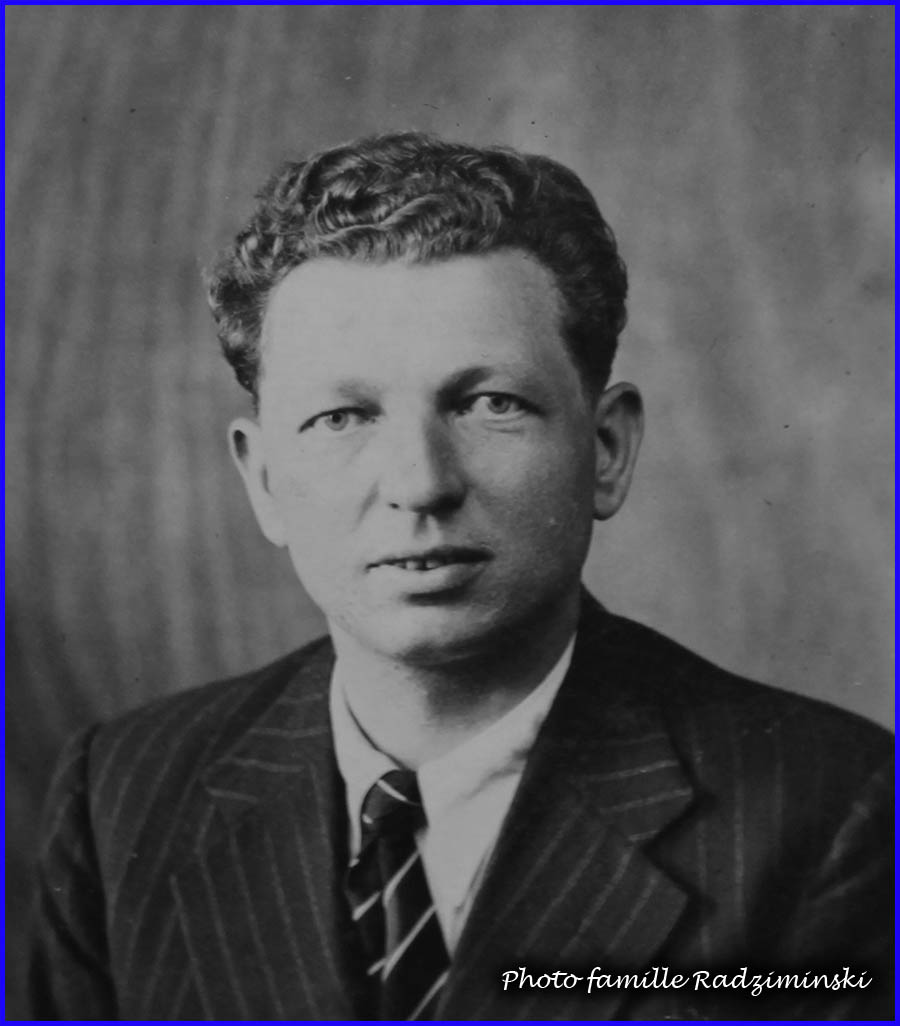
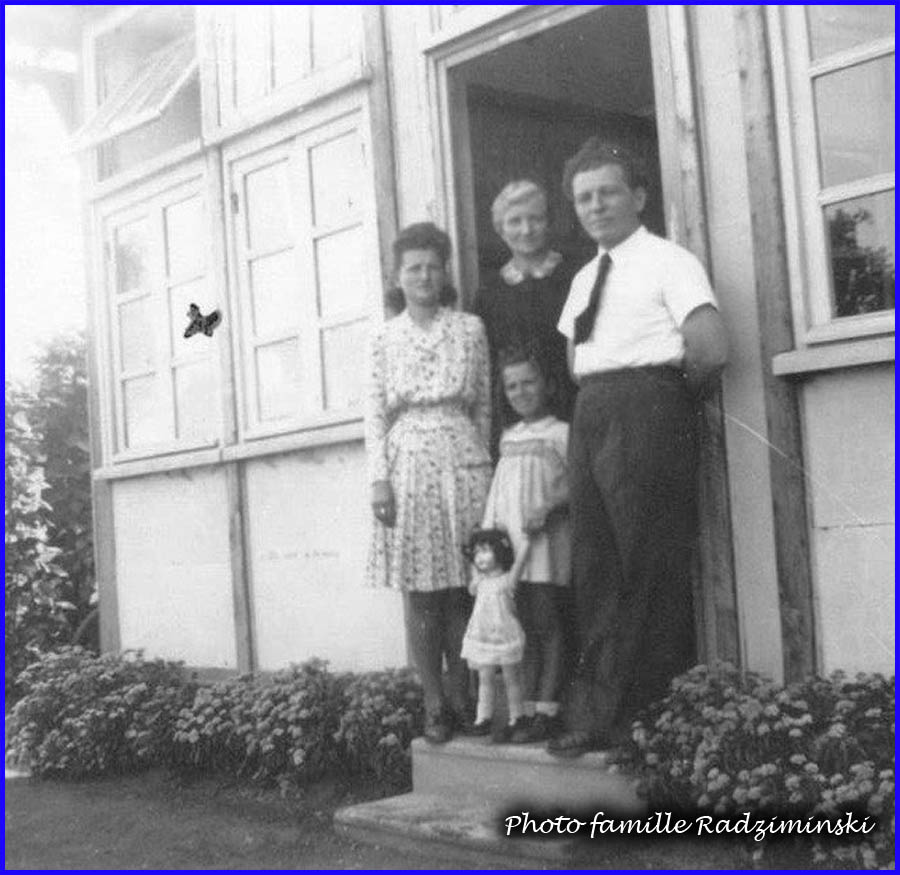
This network also made it possible to conceal soldiers of Polish or Russian nationality, forcibly enlisted in the German Army, whom Bruno Radziminski managed to help to desert. He himself took in seven airmen, including Joseph Houlihan and Louis Watts. All were taken by him to La Garenne-Colombes, in the Paris region, and five of them were handed over to Ellen Walker. A hundred kilometers separates Grandvilliers from la Garenne-Colombes, making one of the most perilous stages of the escape of Louis Watts and Joseph Houlihan. Their move in a truck was however uneventful.
Since the Normandy Landings, Bruno Radziminski led, in parallel with his escape line, direct actions against the German convoys descending from the north and heading towards the Normandy front. On 30th August 1944, he actively participated in the Liberation of Grandvilliers. Informed of the approach of the Allied tanks and having learned of the escape of the German station master, he took his place and thus succeeded in routing by telephone all the stationmasters of the Grandvilliers-Le Treport railway line, thus disorganizing the German network. With his group they took up arms and took several prisoners in the locality.
Bruno Radziminski was in contact with André Rohmer, a baker and member of an Intelligence network at La Garenne-Colombes. The latter specialized in locating and placing Allied airmen in different escape routes (he will claim close to 140 contacts). Through a liaison officer, the two men agreed to entrust Louis Watts and Joseph Houlihan to Ellen Walker, at La Garenne-Colombes. The convoy arrived on 21st July.
Ellen Walker was 38 years old. Joining the organized Resistance through Claude Jubert, son of the mayor of La Garenne-Colombes, she acted in the lodging of Allied airmen and those avoiding the Compulsory Work in Germany, in the distribution of clandestine newspapers and the delivery of false identity cards. A British subject, she was required to report daily to the police station. She was then said to be in connivance with sympathizers and could collect valuable information about the imminent arrests by the Gestapo. Though closely under surveillance, Ellen Walker continued to discretely help Allied airmen.
Louis Watts and Joseph Houlihan spent a few days with Ellen Walker. During this time, André Rohmer made contact with Charles Paris and advised him of the temporary placement of the airmen. Charles Paris was a former draftsman of 38 years. He was now totally dedicated to serving the Kummel network of which he was one of the organizers. At that time, he faced many difficulties with regard to the impossibility of evacuating the airmen sheltered in the Paris region, to Bordeaux. The transport services being interrupted, he had to find accommodation for the airmen who continued to arrive. Anticipating the risk of a search of Ellen Walker's home, Louis Watts and Joseph Houlihan were moved to nearby avenue Foch. Ellen Walker would continue to look after them with the complicity of Elisabeth Derrey and Georges Mauger.
On 25th July, the Allies managed to break through the German defenses in Normandy. The American divisions rushed into it and attacked from the rear the Germans, who suffered heavy losses, trapped in the Falaise Pocket. Faced with this push, the Germans were retreating. Meanwhile Charles Paris spared no effort in order to feed about twenty men hidden in the Paris suburbs for which he was responsible. Five of them were sheltered at La Garenne-Colombes in the care of Ellen Walker and Renee Derrey. Despite the increasing difficulties of supply, they could count on the baker Rohmer and the restaurateur Jean-François Lecoq whose establishment was located at the corner of the street in which Louis Watts and Joseph Houlihan were lodged.
Since mid-August, the US Army was getting closer and closer to Paris, causing a certain effervescence among the population of the capital and of its suburbs. On 19th August was the general insurrection. Street fights, with uncertain outcome, took place between the Germans and the Parisian FFI. Charles Paris was instructed to gather the airmen together and proceed with their evacuation. He undertook to move them as a Red Cross convoy. However, this project was not carried out. On the evening of the 24th August, the bells of the churches of Paris sounded on the arrival of the first tanks of the 2nd French Armored Division and the 4th American Infantry Division. On 25th August Paris was finally liberated. There were widespread celebrations. This intense moment was immortalized at the crossroads of the restaurant Lecoq where the airmen posed for a set of souvenir photos in front of a GMC vehicle. For them and for the whole world, a wind of freedom had risen.
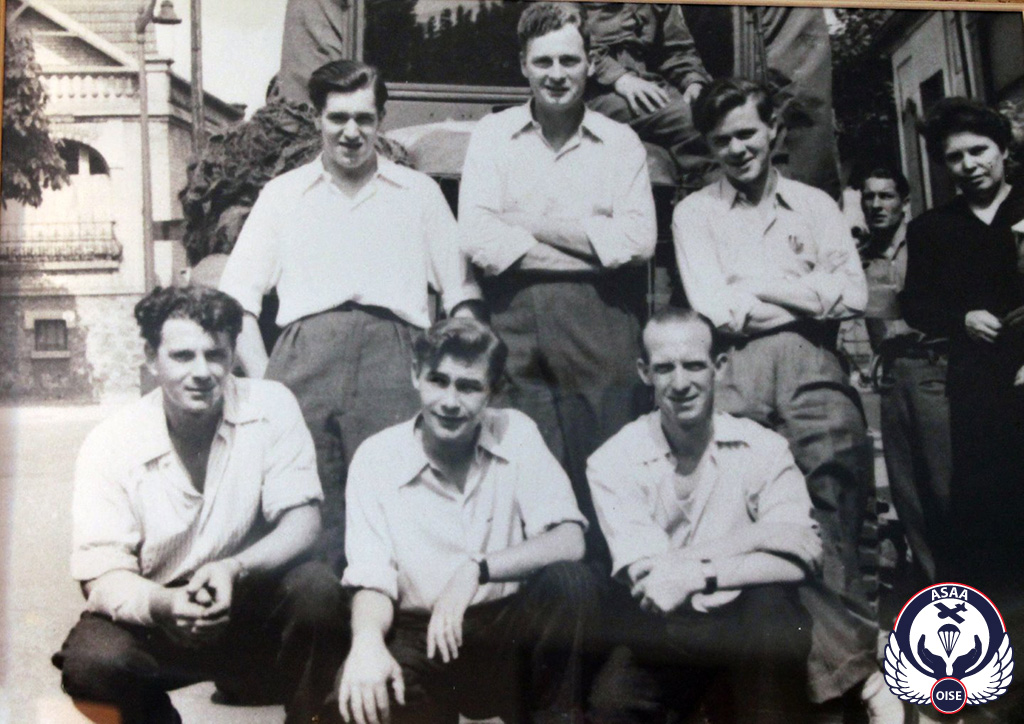
2nd row : Louis Watts is in the middle. Joseph Houlihan is on right next to Mrs Le Coq.
The airmen were then taken to Captain Baker at the Windsor Hotel in Paris where the IS9 had set up its temporary headquarters.
May 2017 : The visit of the WATTS family
September 2019 : Visit of the EDGE, HOULIHAN and WATTS families


